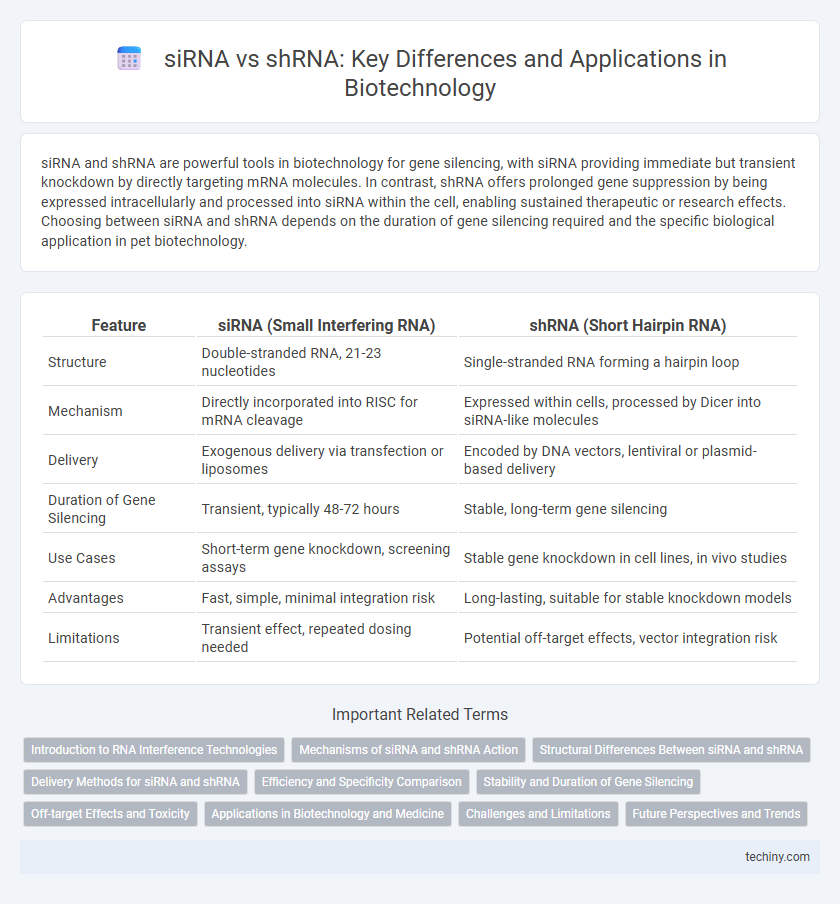siRNA and shRNA are powerful tools in biotechnology for gene silencing, with siRNA providing immediate but transient knockdown by directly targeting mRNA molecules. In contrast, shRNA offers prolonged gene suppression by being expressed intracellularly and processed into siRNA within the cell, enabling sustained therapeutic or research effects. Choosing between siRNA and shRNA depends on the duration of gene silencing required and the specific biological application in pet biotechnology.
Table of Comparison
| Feature | siRNA (Small Interfering RNA) | shRNA (Short Hairpin RNA) |
|---|---|---|
| Structure | Double-stranded RNA, 21-23 nucleotides | Single-stranded RNA forming a hairpin loop |
| Mechanism | Directly incorporated into RISC for mRNA cleavage | Expressed within cells, processed by Dicer into siRNA-like molecules |
| Delivery | Exogenous delivery via transfection or liposomes | Encoded by DNA vectors, lentiviral or plasmid-based delivery |
| Duration of Gene Silencing | Transient, typically 48-72 hours | Stable, long-term gene silencing |
| Use Cases | Short-term gene knockdown, screening assays | Stable gene knockdown in cell lines, in vivo studies |
| Advantages | Fast, simple, minimal integration risk | Long-lasting, suitable for stable knockdown models |
| Limitations | Transient effect, repeated dosing needed | Potential off-target effects, vector integration risk |
Introduction to RNA Interference Technologies
RNA interference technologies harness the cellular machinery to silence gene expression through sequence-specific RNA molecules. Small interfering RNA (siRNA) are synthetic, double-stranded RNA molecules that induce transient gene silencing by guiding the RNA-induced silencing complex (RISC) to degrade complementary mRNA. Short hairpin RNA (shRNA) are genetically encoded molecules expressed within cells, providing stable and long-term gene knockdown by forming hairpin structures processed into siRNA-like fragments.
Mechanisms of siRNA and shRNA Action
siRNA operates through the RNA-induced silencing complex (RISC) by directly binding to complementary mRNA sequences, inducing their cleavage and subsequent degradation, effectively silencing target gene expression. shRNA is transcribed in the nucleus and processed by the enzyme Dicer into siRNA-like molecules that are incorporated into RISC for targeted mRNA degradation, providing longer-lasting gene silencing effects. Both siRNA and shRNA harness the RNA interference (RNAi) pathway but differ in their cellular origins and stability, influencing their mechanisms of action and therapeutic applications.
Structural Differences Between siRNA and shRNA
siRNA consists of short, double-stranded RNA molecules typically 20-25 nucleotides in length, designed to directly mediate gene silencing through RNA-induced silencing complex (RISC) incorporation. In contrast, shRNA features a stem-loop structure formed by a single RNA strand that folds back on itself, allowing intracellular processing by Dicer into active siRNA-like molecules. The structural divergence dictates their cellular processing pathways, with siRNA acting immediately upon transfection and shRNA requiring transcription and nuclear export before gene silencing occurs.
Delivery Methods for siRNA and shRNA
siRNA delivery commonly utilizes lipid nanoparticles and liposomes to facilitate cellular uptake and protect against nuclease degradation, enabling efficient transient gene silencing. In contrast, shRNA is typically delivered via viral vectors such as lentivirus or adenovirus, ensuring stable integration and prolonged gene knockdown in target cells. Both delivery methods are optimized for tissue-specific targeting and minimizing off-target effects in therapeutic applications.
Efficiency and Specificity Comparison
siRNA exhibits rapid gene silencing with high specificity due to its transient nature and precise targeting of mRNA sequences, making it ideal for short-term gene knockdown studies. In contrast, shRNA provides prolonged and stable gene silencing by integrating into the host genome, resulting in continuous expression and efficient knockdown in long-term experiments. Efficiency in gene silencing by shRNA often surpasses siRNA in stable cell lines, but siRNA offers greater control over off-target effects, enhancing specificity in transient applications.
Stability and Duration of Gene Silencing
siRNA molecules typically provide transient gene silencing due to rapid degradation by cellular nucleases, resulting in limited stability and shorter duration of effect. In contrast, shRNA is transcribed within the host cells from a DNA vector, leading to continuous production and more sustained gene silencing over extended periods. The sustained intracellular expression of shRNA enhances stability and prolongs gene knockdown, making it suitable for long-term gene regulation studies.
Off-target Effects and Toxicity
siRNA and shRNA both serve as gene silencing tools, but shRNA often exhibits prolonged expression, leading to increased off-target effects and potential cellular toxicity due to saturation of the RNAi machinery. siRNA, being transiently active, generally shows fewer off-target interactions and lower toxicity, making it preferable for short-term gene knockdown studies. Careful sequence design and delivery optimization are crucial to minimize unintended gene silencing and cytotoxicity in both approaches.
Applications in Biotechnology and Medicine
siRNA and shRNA are pivotal tools in gene silencing for biotechnology and medicine, enabling targeted downregulation of specific mRNA sequences to study gene function and develop therapeutics. siRNA is often used for transient gene knockdown in vitro and in vivo, facilitating rapid screening of gene targets in cancer research and antiviral therapies. shRNA provides stable, long-term gene silencing through vector-based expression systems, making it ideal for generating disease models and exploring chronic treatment strategies in neurodegenerative diseases and genetic disorders.
Challenges and Limitations
siRNA faces challenges including transient gene silencing and susceptibility to degradation by nucleases, limiting its long-term therapeutic efficacy. shRNA provides more sustained gene knockdown but presents risks such as off-target effects and potential cytotoxicity due to high expression levels. Both siRNA and shRNA require efficient delivery systems to overcome cellular barriers and avoid immune responses, which remain significant obstacles in clinical applications.
Future Perspectives and Trends
Emerging trends in biotechnology highlight the advancement of siRNA and shRNA technologies, with an emphasis on improving delivery systems to enhance target specificity and reduce off-target effects. Innovations in nanoparticle-based carriers and exosome-mediated delivery are expected to revolutionize therapeutic applications by enabling precise gene silencing in vivo. Future perspectives include the integration of CRISPR technology with RNA interference methods to create multifunctional gene regulation platforms tailored for personalized medicine.
siRNA vs shRNA Infographic

 techiny.com
techiny.com